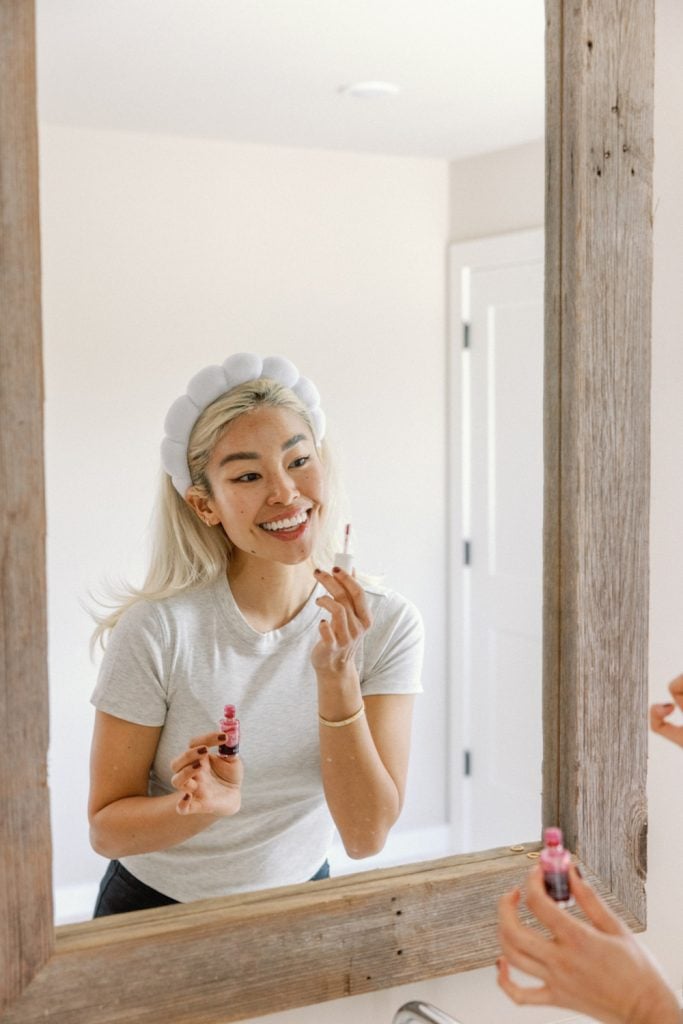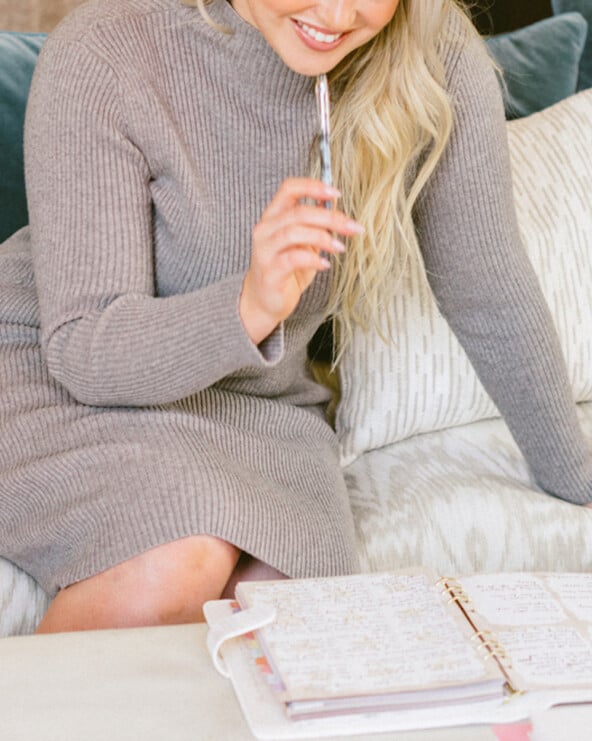TBH, far more than anything else, I’m most self-conscious about my teeth. Of course, I strive for self-love and compassion every day. But I won’t lie—it can be hard to not pick apart my smile in the mirror or criticize every photo. Ugh. And while my identified “issues” lie more in shape and alignment, as a coffee-loving gal, teeth bleaching as an antidote to my less-than-pearly whites has garnered more than a few TikTok deep-dives and late-night Google sesh’s.
If you’ve found yourself going down the teeth-bleaching rabbit hole as well, then you know: there’s plenty of info out there. And unfortunately, not all of it’s credible. With so many questions surrounding cost, side effects, and whether it’s better to do an in-office or at-home treatment, answers abound. When Camille told me that she did in-office teeth bleaching earlier this year (and was thrilled with the natural results), I decided to learn more. So, I connected with Camille’s own Austin-based dentist, Dr. Tony Pacheco, DDS, PA as well as Dr. Derek Gatta, a board-certified prosthodontist and the founder of RiseWell, to sift through the noise.
Ahead, the experts explain the ins and outs of teeth bleaching—including the truth behind all of my previously-mentioned Google searches. To know if teeth bleaching is a good option for you, they have the answers. Let’s dive into them together.
Featured image by Riley Reed


The Difference Between Teeth Bleaching and Whitening
You’ve likely heard the terms thrown around interchangeably in casual conversation. But as it turns out, the two aren’t synonymous. Speaking with Dr. Pacheco, he confirms the subtle, but important difference:
- Teeth whitening. Any method—mechanical or chemical—that restores your teeth to their natural color.
- Teeth bleaching. Any chemical process that lowers the natural hue of your teeth.
Dr. Pacheco discourages whitening versus bleaching in his practice. “Most whitening procedures will involve an abrasive component that may provide short-term benefits of ‘whiter’ teeth that can potentially have long-term negative effects.” In extreme cases, these may include:
- gum recession
- long-term cold sensitivity
- difficulty bleaching your teeth as you age
Determining Eligibility for Teeth Bleaching
This tends to be step two after you begin considering teeth bleaching. Sure, you’d love the bright, whitening results of the treatment, but is it even safe for you to pursue it?
There are several factors that can determine eligibility. Dr. Gatta shares the top reasons to pause the procedure below.
- People with allergies or sensitivities.
- Patients with a mix of previous crowns/composite bondings. Although your natural teeth structure will bleach, the restorations will not change colors and can produce mismatching results.
- Women who are pregnant.
- Children under 16 years of age. They can have heightened sensitivity because the pulp chamber is still developing.


Cost of In-Office Teeth Bleaching
Beyond efficacy, of course, this is where the core of my curiosity lay when it came to teeth bleaching. How deep in the hole would I be if I pulled the trigger?
Know this: the cost can vary widely depending on the exact procedure and provider. Dr. Gatta provides an estimate of between $500 and $1000 for an in-office bleaching treatment.
Sure, it’s a bit to swallow, but the benefits line up. You’re paying top dollar for the experience and expertise of a dental professional. They can monitor and manage the amount of bleach used as well any potential side effects or damage.
If you’re looking to pay whatever it takes for the best results, an in-office teeth bleaching treatment may be the best way to go.
Cost of At-Home Teeth Bleaching
However, if you want to save a little money, consider at-home teeth bleaching, which Dr. Pacheco notes can cost between $25 and $600+. When shopping your options, you’ll find a variance in price depending on several factors:
- strength and quantity of the bleach
- ease of use
- potential for cold sensitivity
To determine the best at-home bleaching product for you, Dr. Pacheco encourages establishing an open and honest line of communication with your dentist. “Bleaching is an inexact science, but your dentist can give you reasonable expectations of potential results after assessing all the factors that are contributing to your smile’s current shade.”
If you’re looking for less of a personalized experience and simply want to save, the least expensive option can be found over the counter at the pharmacy or grocery store. Strips and trays tend to range from $20 to $100. This is the best option if you’re looking for results similar to, and more affordable than, an in-office treatment. But of course, with the lower price comes the potential for non-optimal results.
As for which brand to trust, Dr. Pachecho recommends and carries Ultradent disposable preloaded bleaching trays and Phillips 27% Day White bleaching gel that is delivered in reusable custom trays. “These are great ways to make safe, favorable advances in lightening the shade of your teeth.”
Regardless of which route you choose, we recommend consulting your dentist before purchasing to ensure you’re getting the best product for your desired results.


Tips to Prolong Results
Apologies to all of the coffee lovers out there (me). For best results, limit your consumption of what Dr. Pacheco refers to as “dark staining foods and liquids”—i.e., all of our favorite vices, including coffee, tea, and red wine. To minimize the impact these darker beverages can have on your teeth, he recommends brushing immediately after if possible. This way, “the pigment minimally affect the longevity of your bleaching results.”
Teeth Bleaching Side Effects
Dr. Pacheco confirms: bleaching—”if used within the guidelines set by the manufacture and under the supervision of your dentist”—is a safe procedure. However, he cautions that “some patients may experience some mild to moderate cold sensitivity post-bleaching.” But this is short-lived, and as Dr. Pacheco notes, can be treated with Sensodyne toothpaste formulated specifically for sensitive teeth as well as incorporating additional fluoride gels to your brushing routine.
Again, speak with your dentist as you consider teeth bleaching to determine your eligibility and the best options for you.





